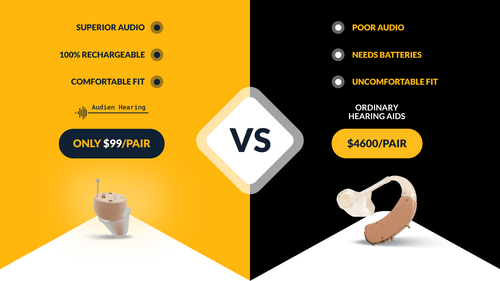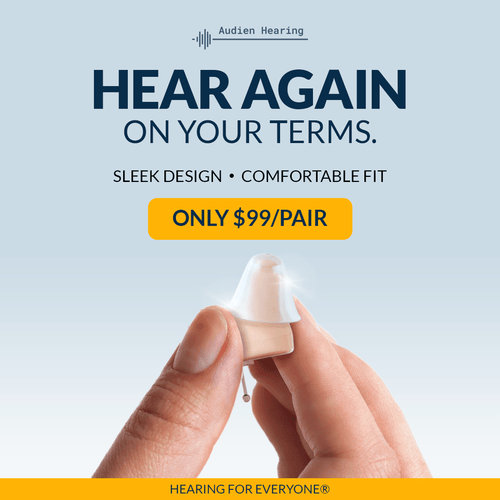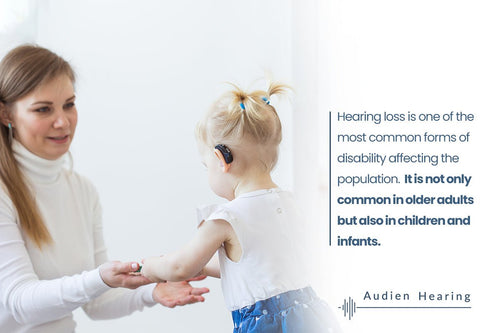
The world keeps changing every single day, and there’s no better place to be with how much new technology has surfaced. When it comes to technological advancement, it seems like every time you queue up your web browser, another article about a breakthrough in the tech world pops up.
When it comes to medical technology, hearing aids have been on the cutting edge for a long time. These incredible devices come in varied shapes and sizes but are all fine-tuned to help you understand frequencies that you naturally have been having trouble hearing.
Technology Is Evolving
The history of hearing aids is extensive. As long as humans have been suffering from hearing loss, there has been a push to create technology that can help to improve it.
Going back as early as the thirteenth century, we have a recorded history of hollow tubes being used to help narrow in on elusive frequencies by people who have had trouble hearing. With every generation, there seem to be more and more advancements in the world of hearing technology, and it continues to grow to this day.
Thomas Edison, who personally suffered from hearing loss, invented a device that amplified the sound on the telephone by about 15 decibels. This device had a minimal impact on any kind of true hearing impairment, but it paved the way for what we now call modern hearing aids.
The twentieth century saw massive advancements in the world of hearing technology, from Thomas Edison’s amplifier to vacuum tube hearing aids to electronic transistors. These advancements eventually led to our modern-day switch from analogue to digital technologies.
As hearing aids have progressed, they have followed certain trends regarding size, power, and connectivity. More hearing aids are being produced and marketed as ‘invisible’ when you wear them.
The power source of hearing aids has also constantly changed to require less maintenance. For example, Auiden carries hearing aids that have rechargeable capabilities.
Hearing aids have also continued to become more connected with a recent advancement; Bluetooth technology. This technology uses radio waves to communicate between devices and does so harmlessly without interfering with other frequencies.
This platform of technology is established and widely used between devices regardless of brand or origin. Most devices that you purchase have built-in Bluetooth capabilities because the experience is so reliable and commonly used.
Why Bluetooth?

If your hearing aid has Bluetooth capabilities, how can it help you improve your hearing?
Listening To Music
Your hearing aid is specifically designed to help you recognize and understand frequencies that have naturally become hard for you to detect. This is due to the way your ears function, in that you have sensitive equipment within the hearing organ that responds specifically to certain frequencies at certain decibel levels.
Once you have identified the frequencies you have trouble with, your hearing aid will help you recognize them. So, when it comes to music, simply putting in a pair of earbuds or slapping on a pair of headphones won't necessarily improve your listening experience if you are struggling to hear certain frequencies more than others. However, your Bluetooth hearing aids can help you hear any music that is playing around you.
Control
One of the key benefits of Bluetooth technology is using this feature to control your devices wirelessly. You need to know some general guidelines if you are setting up and troubleshooting your Bluetooth hearing aids.
If your hearing aids are linked to your phone via Bluetooth and the manufacturer has developed an app to act as a command center, you can adjust volume and a multitude of other features wirelessly.
This is a big advantage, as it doesn’t matter what size hearing aid you have. Manually adjusting these features can represent a tedious task.
Setting Up Your Bluetooth Hearing Aids
Bluetooth is an established platform used by all kinds of technology, manufacturers, and producers. This means that there are some universal methods of engaging with this technology across multiple hardware platforms.
If you are using an iPhone or Android, a PC or a MAC, the systems are similar, and here are some general rules to help guide you through your process.
Make Sure All Devices Are On, and Bluetooth Is Enabled
You can test your device’s Bluetooth capabilities by ensuring that all of your devices are on, adequately charged, and the Bluetooth option has been turned on. Bluetooth technology can be thought of as a third-party, universal feature.
Like wifi, if your device can connect to Bluetooth, it can most likely be turned off or on. Devices like iPhone and Android, and many others have control centers that house your devices' general settings. The ability to turn Bluetooth off and on is typically housed in settings. Once you have made sure that both devices are one, you can move on to the next step.
Pairing Your Devices
If you have never paired your Bluetooth device to another device before, there are a few things you need to do in order to set it up. After making sure that your device is on and set to pair, you should see its name pop up in the pairing menu. Once you see it available, select it for connection.
For devices you have paired with Bluetooth in the past, most technology will have a dedicated list of devices that have been paired before. Your devices usually remember past pairings to Bluetooth for future use, so you don’t have to set it up each time you use it.
What To Do When It’s Not Working: Universal Steps for Troubleshooting

As dependable as the world of technology is, sometimes it might not be as reliable as we want it to be. Whether that means when you pull out your phone to connect to your hearing aids and realize that your phone has a low battery, or you are having trouble setting up your Bluetooth to begin with. Technology presents amazing tools that at times, need a little TLC and troubleshooting to make it functional.
Bluetooth can be considered a universal feature despite the brand, manufacturer, or type of device. Troubleshooting is varied depending on what device you have. If you have been experiencing some issues with connectivity between your hearing aids and the desired devices you want to connect to, just take a deep breath and follow these easy guidelines.
Make Sure Your Devices are Adequately Charged
Bluetooth does represent another drain on your battery. Not only will you notice an impact on the battery life of both devices while using Bluetooth, but you may experience problems connecting your Bluetooth devices if you don’t have an adequate charge.
This may look like your device powering down shortly after connecting or maybe even your device not being able to connect at all. Simply connect your devices to a charging station and then try the process again.
Pairing Issues
When you can’t connect your device at all or maintain a connection, this can be considered a pairing issue. This can mean that your devices are having trouble recognizing each other.
Here are some quick, easy steps to following in that case.
First, make sure that Bluetooth is on and functioning on both devices. Once that has been established, go to the menu on your device you are connecting through and see if the desired hearing aids you wish to connect to are present. Try looking for the hearing aids name in the device you are trying to pair them to. If you don’t see their name pop up in that pairing menu, turn off Bluetooth and turn it back on.
If you see the device name that you desire to connect to, but it won’t connect, see if you can ‘forget the device’ and remove it from your connection menu. Usually, this is an option that can be accessed by selecting the hearing aids in the pairing menu and choosing ‘unpair.’ Once this has been done, re-pair your devices.
Turn It Off and Turn It Back On
If all else fails, repower both devices and start from scratch. Doing a hard reset is sometimes needed to jump-start the connectivity if the other steps have failed.
Bluetooth Hearing Aids: Coming Soon
At Audien, we are currently developing our first-ever line of Bluetooth over-the-counter hearing aids.
"The advent of Bluetooth technology has been a game-changer for hearing aid users." - Drew Sutton, MD, Board-Certified Otolaryngologist.
The most important thing to remember when troubleshooting your Bluetooth devices is to keep calm and follow these steps to ensure a successful connection to your hearing aids. If you continue to face connection problems, reach out to your healthcare provider or contact the device manufacturer, as these issues are not uncommon.
If you’d like to learn more, Audien is your one-stop shop for helping you stay informed on affordable hearing aid options and resources.
Sources:
Hearing Aid History: From Ear Trumpets to Digital Technology – EMBS













